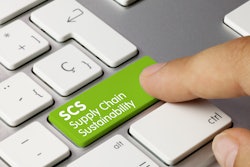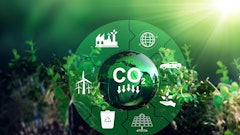
Once upon a time, sustainability was simply a buzzword surrounding concerns about the future of a world riddled with practices that offered less regard for waste and pollution. Now, sustainability is a true practice with real efforts behind maintaining and implementing eco-friendly alternatives within any organization. Nowhere is this shift more evident than in the realm of supply chain management, where the concept of the "Green Supply Chain" is gaining momentum. This transformative approach emphasizes environmental responsibility and seeks to minimize the ecological footprint of the entire supply chain process.
For Steven Liu, VP of strategic sourcing and purchasing at Legrand, it’s not only about how we reduce carbon in the context of products but also about where we buy and how we transport those products. "Green supply chain is about taking into account the full life cycle of our products and working to reduce impacts across the value chain."
According to research, a company’s supply chain is a huge contributor to their total emissions (up to 80% are scope 3—which are largely in a company’s supply chain), waste and inequality. This poises the industry as a major area of opportunity to improve sustainability overall, with a concerted and thoughtful effort.
Sophia Mendelsohn, chief sustainability and commercial officer for SAP Sustainability, explains green supply chain with that same focus on end-to-end transparency, extending from sourcing to product development, manufacturing, distribution and disposal after use to minimize waste and encourage circularity. In the era of digital transformation, Mendelsohn says, the growing sophistication of digital supply chain technologies like AI and blockchain are playing a key role in the evolution of sustainable practices. Today, companies bear an increasing responsibility to showcase their corporate social responsibility practices and in turn, ethical supply chain practices are gaining priority.
"I cannot overstate the importance of a sustainable supply chain as it plays an important part in combatting climate change, one of the largest challenges of our generation and the next generation. But sustainability makes sense for business too, with one report noting that by 2030 sustainable business efforts could drive up to $12 trillion in value," says Mendelsohn. "Research from SAP also indicates that 83% of consumers would be more likely to buy from a brand that supports and sources from local suppliers and over half (55%) would pay more for ethically sourced goods. And technology plays a critical role in helping businesses build a green, transparent and circular supply chain."
The Future with EV
One of the more prominent trends in the pursuit of a green supply chain is the integration of EVs into fleets. Traditional supply chain operations heavily reliant on fossil fuels contribute significantly to carbon emissions and environmental degradation. In response, companies are now investing in electric delivery vans, trucks and even drones to reduce their carbon footprint.
"The use of EVs within the supply chain – whether within the logistics network or even the sales fleet– does a couple of things. One, they help to decrease our emissions as an organization, and two, help to visibly demonstrate our commitment to sustainability to our customers and stakeholders. Imagine a salesperson showing up to demonstrate building energy management products in a giant gas-guzzling vehicle – we need to walk the talk," explains Liu.
EVs bring a myriad of environmental benefits that include lower emissions, reduced air pollution and decreased dependency on non-renewable energy sources. Major players in the e-commerce sector are actively incorporating EVs into their fleets, actively demonstrating their commitment to cleaner, more sustainable transportation practices— aka the green supply chain.
Growing the Circular Economy
Another noteworthy aspect of the green supply chain revolution is the adoption of circular economy principles. Unlike the traditional linear economy, the circular economy focuses on minimizing waste and maximizing the lifespan of products and materials. Mendelsohn describes the linear economy as not only financially wasteful for business, but also coupled with significant negative environmental and social impacts. Companies must focus on reinventing the way they manage materials so they can achieve zero waste and integrate into a regenerative economy, Mendelsohn explains, and it starts with how products are designed.
"We must consider the end-of-life of a product and the packaging materials used–in addition to production, distribution and the actual use of the product. You can see that, for example, in companies’ buyback programs, where consumers can sell their old clothes or furniture back to the company they’ve purchased it from," details Mendelsohn.
So, companies are reevaluating their product design, manufacturing processes and packaging strategies to adhere to these principles. This involves prioritizing recyclability and reducing single-use materials. Additionally, Liu says it includes utilizing by-products in other manufacturing processes that would otherwise be wasted and where recovered materials can be reincorporated as feedstock for new products. By embracing a circular economy approach, businesses can contribute to the reduction of landfill waste and promote the responsible use of resources throughout the supply chain.
The Wins, Woes and Regulations
Today we see tangible benefits to sustainability. Beyond the obvious environmental advantages, companies engaging in sustainable supply chain management often experience improved brand reputation, increased operational efficiency and cost savings through reduced energy consumption.
"Companies are seeing a transparent and sustainable supply chain as a differentiator for their business. Digitizing supply chains is one of the most effective ways for businesses to achieve full visibility into the operations of their own and their trading partners’ network," says Mendelsohn. "Collaboration across business networks make it possible to share information and use data insights to improve efficiency and decision-making. This is particularly important in the current climate of uncertainty and unpredictable changes in consumer demand."
For many companies, the use of data is propelling the crusade forward with a shift from looking at industry estimates and averages to calculating carbon footprint to using accurate and verifiable data. Mendelsohn says the next step is to combine financial and carbon data so that sustainability is woven into core business processes and decision-making.
In manufacturing, guidelines for eco-design, Liu says, helps product development teams find more sustainable ways of designing and sourcing materials for products. "Within the manufacturing supply chain, we are putting more guidelines around energy reduction in manufacturing plants. Many organizations are even publicly sharing their internal tools and strategies for how to improve supply chains through online platforms or white papers. Supplier engagement is critical—educating suppliers on how to be environmentally sustainable and build the knowledge base improves everyone’s performance," explains Liu.
However, it's not all as simple as it sounds. Transitioning to a green supply chain is not without its challenges. Upfront costs associated with the implementation of EVs, digital platforms and the restructuring of supply chain processes can be substantial. Overcoming these financial barriers requires a long-term perspective and a commitment to the greater good.
According to Mendelsohn, "In order to make a truly green supply chain, businesses must also invest in advanced technology and couple that with change management to ensure changes cascade throughout the organization. However, by viewing sustainability as an investment coupled with enhanced resilience and overall savings, companies can overcome challenges and create a positive impact on both the environment and their bottom line."
Beyond regulations, pressure from investors, shareholders and even the average consumer are also driving companies to be accountable for their emissions and with that comes the realization that, in order to meet those needs, outdated reporting should be revamped to maintain true visibility and compliance. Additionally, collaboration is truly the forefront of this topic and partnerships, sharing best practices and investing in research and development is vital to further advance the sustainability agenda.
As green supply chain practices continue to gain momentum, collaboration and innovation will play pivotal roles in shaping its trajectory. Governments, businesses and consumers must work together to incentivize sustainable practices and push for the development of eco-friendly technologies.
Regulations ebb and flow, with requirements constantly changing, and they depend on factors like the type and size of the business, and geographies where the business operates. "We see more human rights due diligence laws like the German Supply Chain Due Diligence Act and fees like plastic taxes in addition to stricter reporting requirements like the EU Corporate Sustainability Reporting Directive (CSRD) and the Cross Border Adjustment Mechanism (CBAM). All of these regulations can have significant financial and operational implications," explains Mendelsohn.
When it comes to meeting these requirements, with recyclable materials for example, companies should comply with authenticity by making sure that recycled content purchased is certified. Liu says that when using new materials, make sure they comply with the regulatory forum that we have that ensures the product is acceptable for the market. Companies should also increase regulation in the social aspect of sustainability, free from forced labor, with verification as to the origin of materials.
The green supply chain is not just a fleeting trend—it represents a fundamental shift in how businesses approach logistics and environmental stewardship. With all the advancements and options presented, and up and coming, that support this notion, the future of supply chain management is poised to be more sustainable, efficient and responsible.



















